The World of the Mexica: An In-Depth Examination of Aztec Society
Overview and Introduction
From about 1300 to 1521, a complex society thrived in central Mexico. We know these people as the Aztecs, but they built a powerful empire from their amazing island capital, Tenochtitlan. Their culture was built on the ideas of older groups like the Toltecs.
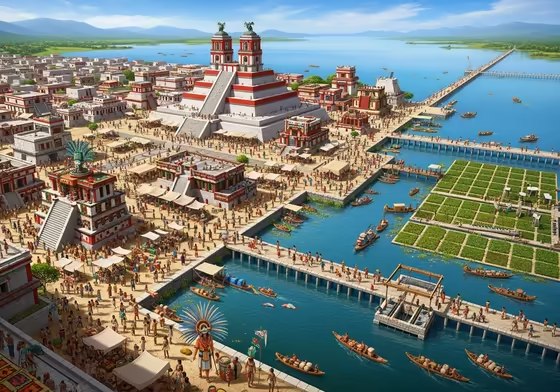
Aztec society was a world of contrasts. It had a very organized social system but also a fierce warrior culture. They were brilliant farmers who developed new ways to grow food, but their deep spiritual beliefs required human sacrifice.
At the heart of Aztec life were two main things: farming and fighting. This influenced their economy, government, and religion. Their empire was not one giant country but a collection of city-states, called altepetl, that were forced to pay tribute and provide soldiers.
Society was strictly divided between nobles (the pīpiltin) and common people (the mācehualtin). Each group had its own rules, jobs, and benefits. This system was designed to keep the universe in balance and help the empire grow.
It is important to know what these people called themselves. They were known as the Mexica (pronounced Me-SHEE-ka), or more specifically, the Tenochca, who were the people from Tenochtitlan. The name "Aztec" became popular much later in the 19th century.
We will use the name "Mexica" because it is more accurate. The Mexica were just one of several related groups in the area, including their enemies, the Tlaxcalans. When the Spanish arrived, they teamed up with these other groups who saw the Mexica as rulers who controlled them unfairly.
The Spanish did not conquer the empire alone. They led a large rebellion of local people against the Mexica. Using the single name "Aztec" for all these groups hides this important fact about their history.
Timeline and Geography
The Mexica civilization was centered in the Valley of Mexico, a large basin surrounded by mountains. The valley had five connected lakes, with the most important one being Lake Texcoco. This is where the Mexica would build their empire.
In 1325, the Mexica founded their capital city, Tenochtitlan, on a swampy island in the lake. Their legend says their main god, Huitzilopochtli, told them where to build. He sent them a sign: an eagle eating a serpent while sitting on a cactus, which is now the symbol on Mexico's flag.
Living on a lake inspired amazing engineering. The Mexica built long roads called causeways to connect the island city to the mainland. They also created a smart farming system called chinampas, or "floating gardens."
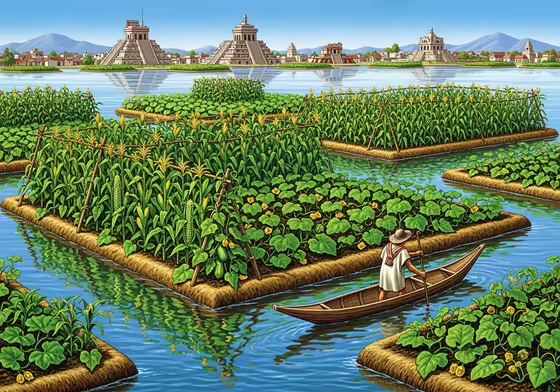
These were man-made islands of fertile mud from the lake bottom. They allowed the Mexica to grow crops like corn, beans, and squash all year to feed the city's huge population. At its peak, the Aztec Empire was the main power in the region, stretching from the Pacific Ocean to the Atlantic coast.
The rise and fall of the Mexica happened very quickly. The empire was a major power for less than 100 years before it came to a dramatic end.
| Date/Period | Event | Significance |
|---|---|---|
| c. 1100–1300 CE | Migration of the Mexica into the Valley of Mexico | The Mexica arrive in the area as a new, wandering group. |
| 1325 CE | Founding of Tenochtitlan | The Mexica establish their capital city on an island in Lake Texcoco. |
| 1428 CE | Formation of the Triple Alliance | The Mexica, Texcoco, and Tlacopan join forces, officially starting the Aztec Empire. |
| 1440–1469 CE | Reign of Motecuhzoma I | The empire expands greatly and gains power by conquering large territories. |
| 1502–1520 CE | Reign of Motecuhzoma II | The empire reaches its largest size right before the Spanish arrive. |
| November 8, 1519 | Arrival of Hernán Cortés in Tenochtitlan | The first meeting between the Mexica emperor and the Spanish, leading to conflict. |
| 1520–1521 CE | Smallpox epidemic devastates the capital | A new disease from Europe kills up to half the population, who had no immunity. |
| August 13, 1521 | Fall of Tenochtitlan | The Spanish and their native allies capture the capital, ending the Aztec Empire. |
Social Structure and Hierarchy
Mexica society was organized like a pyramid, with strict rules for everyone. A person's place in society decided what clothes they wore, what food they ate, and what their life would be like. The biggest divide was between the nobles, called pīpiltin, and the commoners, called mācehualtin, part of the Aztec social classes that structured daily life.
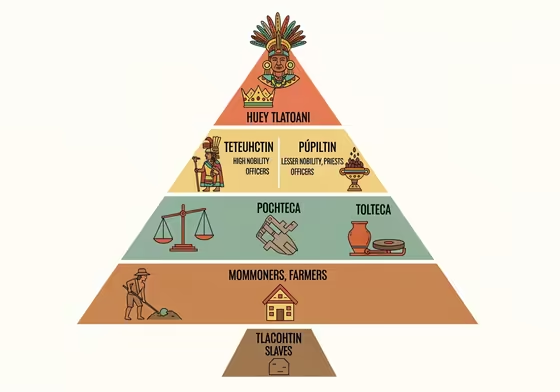
At the very top was the emperor, the Huey Tlatoani, who was seen as being almost a god. Below him were the nobles, which included priests, army commanders, and top government officials. The nobles controlled the land, led the army, and did not have to pay taxes.
You could easily tell who was a noble by their fancy clothes. They were the only ones allowed to wear bright cotton clothing and amazing feather outfits. A commoner wearing these items could be punished by death.
The commoners were the largest group, but they had their own rankings. The most powerful commoners were the pochteca, who were long-distance traders. They traveled far to get luxury goods for the nobles and sometimes acted as spies for the empire.
Also respected were the master artisans, or tolteca. These were skilled workers like feather workers, goldsmiths, and sculptors. They created the beautiful art and religious items seen in temples and palaces.
The biggest group of commoners were farmers, workers, and regular soldiers. They were organized into clans called calpulli and had to pay tribute to the nobles with their work and goods. They were the backbone of the empire's economy and army.
At the very bottom were slaves, known as tlacohtin. However, slavery in Aztec society was very different from what we might think. It was not based on race, and people were not born into it.
A person might become a slave to pay off a debt or as punishment for a crime. Slaves had certain rights, like being able to marry, own property, and buy their own freedom. Their children were born free.
The social structure was strict, but not impossible to move up in. The main way a commoner could rise in status was by being a very brave warrior. A soldier who captured several enemies in battle could become a famous Eagle or Jaguar Knight.
This achievement could earn him a noble status and give him some of the same benefits as nobles, like owning land. This system encouraged everyone to support the empire's goals of warfare and collecting tribute. The social pyramid was a powerful tool for keeping the empire strong.
| Class/Rank | Nahuatl Term | Primary Roles & Responsibilities | Key Privileges & Restrictions |
|---|---|---|---|
| Ruler | Huey Tlatoani | Supreme leader, military commander, high priest | Seen as a god, lived in a palace, had absolute power. |
| High Nobility | Teteuhctin | Governors, high court judges, top state officials | Owned large private estates, wore the best clothes, did not pay tribute. |
| Lesser Nobility | Pīpiltin | Government workers, military officers, priests | Born into the class, owned private land, received tribute, wore fancy clothes. |
| Merchants | Pochteca | Traded luxury goods over long distances, acted as spies | Had their own guilds and laws, became very wealthy, lived in their own neighborhoods. |
| Artisans | Tolteca | Skilled craft workers (featherwork, goldsmithing, art) | Highly respected for their skill, often worked in special shops. |
| Commoners | Mācehualtin | Farming, building projects, regular soldiers | Organized into clans, worked shared land, had to pay tribute and serve in the army. |
| Slaves | Tlacohtin | Served others due to debt, crime, or being captured in war | Not a lifelong condition; could own property, marry, and buy their own freedom. |
The Calpulli and Family
The most important social group was the calpulli, which means "big house." It was a group of families that were related to each other, like a clan. The calpulli was also the main group that held land for commoners.
The land was owned by the whole group, and its leaders would give plots to families to farm. In return, families had to pay tribute and be loyal to the calpulli and the state.
In big cities like Tenochtitlan, a calpulli was like a neighborhood, often based on a specific job like a guild. Each calpulli had its own temple and its own school, the telpochcalli, where young men learned to be warriors. The family was the building block for this entire system, shaping Aztec family life.
Socialization and Education for Children
The Aztec government had a system of required education for all children, which was advanced for its time. The lessons were different for each social class and gender. Children were raised from birth to fit into their future roles in society.
Around age 15, boys started school. The sons of commoners went to the telpochcalli in their neighborhood, where they learned practical skills and how to be a soldier. They went through tough physical training and learned how to use weapons.
The sons of nobles went to an elite school called the calmecac. Their education was much more serious and focused on creating future leaders like priests and commanders. They studied history, law, and astronomy, and practiced fasting and other rituals to build discipline.
Girls also went to school, but separately from boys. Their education focused on skills for running a home. They learned to cook, spin thread, and weave cloth, which was a very important job.
Government and Leadership
The Aztec government was centered on the emperor, the Huey Tlatoani of Tenochtitlan. The emperor was believed to be chosen by the gods and had total power. He was the top military commander, head of the government, and the highest religious leader.
The Aztec Empire was not a single, unified country. It was a military partnership called the Triple Alliance, formed in 1428 by three powerful city-states: Tenochtitlan, Texcoco, and Tlacopan.
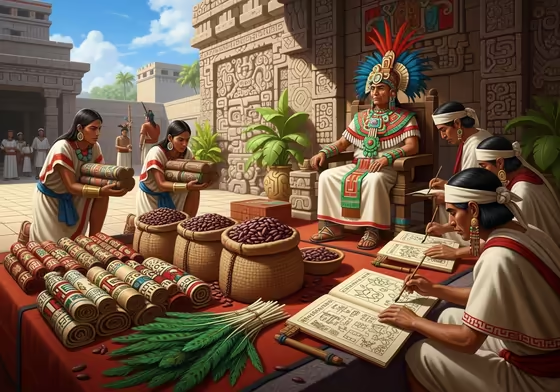
Although they started as partners, Tenochtitlan quickly became the most powerful member. Tribute collected from conquered lands was split between the three cities. Tenochtitlan and Texcoco each got two-fifths, while Tlacopan got one-fifth.
The basic political unit in the area was the altepetl, or city-state. The Aztec Empire was built by conquering hundreds of these smaller states. Instead of ruling them directly, the Triple Alliance let local rulers stay in power as long as they paid tribute.
This system of indirect rule helped the empire expand quickly. However, it also created a lot of anger among the conquered people. They were forced to pay heavy taxes and provide people for human sacrifice in Tenochtitlan.
This anger was a major weakness. When the Spanish conquistador Hernán Cortés arrived, he used these tensions to his advantage. He convinced angry city-states like Tlaxcala to join him and fight the Mexica.
The legal system had a clear structure. Small cases were handled in local courts or markets. More serious crimes, especially those involving nobles, were heard by high courts in the emperor's palace.
Daily Life and Gender Roles
For most Mexica people, daily life was shaped by farming and the needs of the state. Men woke up at dawn to work in the fields or on projects like building temples and roads. Their main crops were corn (maize), beans, and squash, also known as the "Three Sisters."
The common diet was mostly vegetarian. Meat like turkey or fish was usually saved for special events. Women's work began at home and centered on the very hard job of preparing corn.
They would soak the corn and spend hours grinding it on a stone to make dough for tortillas, which were eaten at every meal. The rest of their day was spent cooking, cleaning, caring for children, and weaving cloth.
Commoners lived in simple, one-story houses made of adobe bricks. Only nobles were allowed to build two-story houses. Even though their homes were simple, the Mexica valued cleanliness and bathed daily, which surprised the Spanish.
Men's Roles
An Aztec man's life was defined by two main duties: providing for his family and serving the state as a warrior. All men, rich or poor, had military training from a young age and were expected to fight in wars. For commoners, the main job was farming on their family's land or on the land of nobles. Men were also expected to help raise their sons and teach them their trade.
Women's Roles
Aztec women were very important in society. While men controlled public life like war and government, women had great power in the home, economy, and spiritual world. A woman's main jobs were to manage the household, prepare food, and raise children.
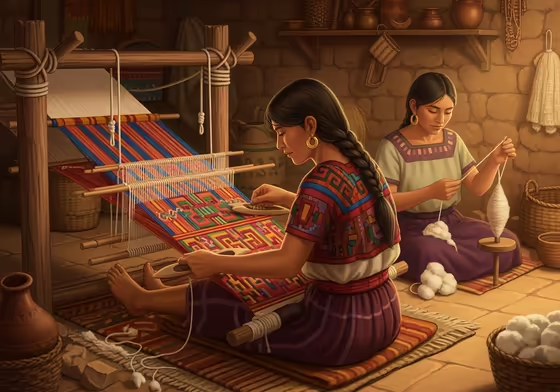
Their most important economic role was weaving. Women made huge amounts of cotton cloth, which was used for more than just clothing. It was a key form of tribute payment, a valuable item to trade, and a sign of social status, acting almost like money.
Women were not just limited to the home. They could own property, sell goods in the market, and go to court to seek justice. Some women became priestesses or midwives, which were highly respected positions.
Childbirth was seen as a battle, and a woman who died giving birth was honored just like a warrior who died in combat. This shows how the Aztecs saw the roles of men and women as different but equally important for keeping the world in balance.
Military and Warrior Culture
The Mexica state was built for war. Warfare was the driving force behind their economy, religion, and society. Every boy was raised to be a warrior from the day he was born.
The main goal of Aztec warfare was different from European warfare. The goal was not to kill the enemy on the battlefield, but to capture him alive. This was because their religion required a steady supply of people for human sacrifice.
Their most famous weapon, the macuahuitl, was a wooden club with sharp obsidian blades. It was designed to injure and knock out an opponent so they could be captured, not to kill them instantly. This approach was a major disadvantage against the Spanish, who fought to kill.
The Aztec army had elite warrior groups. The most famous were the Eagle Knights and Jaguar Knights. A commoner could join these groups by showing extreme bravery and capturing several enemies in battle.
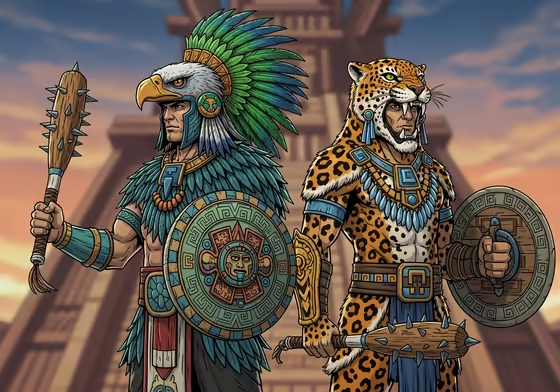
Being in one of these groups brought noble status and special privileges, like wearing amazing warrior costumes. The most feared warrior groups, however, were only for the nobility.
To practice their skills and get captives for sacrifice, the Mexica also fought in ritual battles called Xochiyaoyotl, or "Flower Wars." These were pre-arranged fights against their traditional enemies, like the Tlaxcalans. The goal was not to conquer land but to give warriors a chance to show their skills and capture opponents.
Culture, Values, and Identity
The people we call Aztecs called themselves the Mexica or Tenochca. Their identity was tied to their main god, Huitzilopochtli, their capital city, Tenochtitlan, and their language, Nahuatl. Their view of the world was shaped by a deep religious and philosophical system.
Aztec Values and Morals
Aztecs believed that life on earth was a "slippery" place where it was hard to stay balanced. The goal of life was not to be happy but to live a "rooted life." This meant finding stability in a world that was always changing.
This belief came from their concept of teotl, a single, sacred energy that made up all of reality. This energy showed itself in pairs of opposites, like life and death or light and dark. A good life was one lived in moderation, finding a middle path between these extremes.
Cultural Achievements
The Mexica had many cultural and technological achievements. Three of their most impressive accomplishments stand out:
- Compulsory Education: The Mexica were one of the first societies to have required schooling for all children, including girls and commoners. This made sure everyone understood their role in society and their history and traditions.
- Chinampa Agriculture: To feed the huge population of their island capital, the Mexica created the chinampa farming system. These "floating gardens" were so fertile they could produce up to seven harvests a year, making them one of the most productive farming methods ever created.
- Dual Calendar System: The Mexica used two calendars at the same time. One was a 365-day solar calendar for farming, and the other was a 260-day sacred calendar for religious events. The two calendars would line up perfectly once every 52 years, an event they celebrated with a special ceremony.
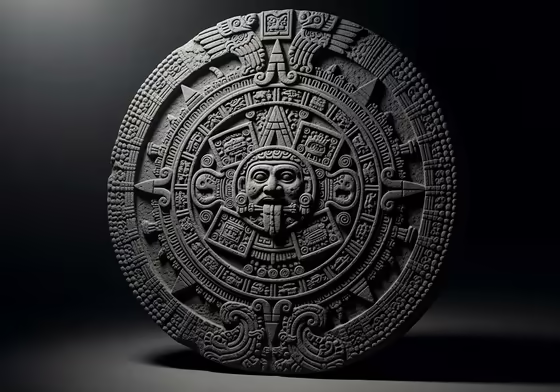
The Aztecs were known for their powerful empire, amazing capital city, and advanced knowledge of engineering. They also had a strong warrior culture and beautiful art. All of this was tied together by a complex religion that included human sacrifice.
Religion and Symbolism
Religion was part of everything in Aztec life, from farming to fighting. They believed in a single, divine force called teotl that was in everything. This force showed itself in the form of many different gods and goddesses, each representing a part of nature or human life.
The most important temple in Tenochtitlan had two shrines at the top. One was for Huitzilopochtli, the god of the sun, war, and sacrifice. The other was for Tlaloc, the god of rain and farming.
Other major gods included Quetzalcoatl, the "Feathered Serpent," who was linked to knowledge and creation. His rival was Tezcatlipoca, the "Smoking Mirror," a powerful god associated with fate and darkness.
Human sacrifice was a key part of their religion. The Mexica believed the gods had sacrificed themselves to create the world and make the sun move. To repay this debt and keep the universe in balance, humans had to offer the most valuable thing they had: human life and blood.
Numbers also had deep symbolic meanings. The number 13 was especially sacred because it represented a full cycle. The universe was thought to have 13 levels of heaven, and their sacred calendar was based on cycles of 13 days.
Legacy and Modern Connections
The powerful Mexica society came to a sudden end when the Spanish conquered Tenochtitlan on August 13, 1521. There were three main reasons for the fall of the Aztec Empire. First, the Spanish had better weapons, like steel swords and cannons.
Second, the Spanish leader Hernán Cortés was a skilled strategist. He made alliances with local groups who hated the Mexica. These allies provided most of the soldiers needed to attack the capital.
The third and most deadly factor was disease. In 1520, a smallpox epidemic swept through Tenochtitlan. The local people had no immunity to this European disease, and it killed up to half the population, including their emperor and many warriors.
Even though their empire was destroyed, the legacy of the Aztecs has a lasting impact on modern society, especially in Mexico.
- Language and Cuisine: The Aztec language, Nahuatl, is still spoken by over 1.5 million people in Mexico today. Many Nahuatl words are now part of English, such as chocolate, tomato, avocado, and coyote. Modern Mexican food is also based on Aztec staples like corn, beans, and chilis.
- National Identity: The Mexica legacy is a core part of Mexico's national identity. The name "Mexico" comes from the Mexica people. The image on the Mexican flag, an eagle on a cactus with a snake, comes directly from the legend of how Tenochtitlan was founded.
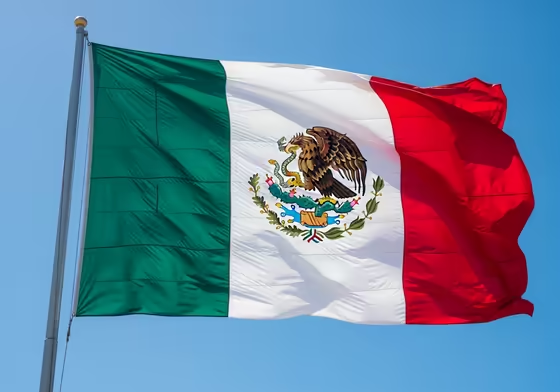
So, are there any "100% Aztecs" left today? The original Aztec society was destroyed, but their direct descendants are the Nahua peoples of modern Mexico. After 500 years of mixing with Spanish colonists, it is difficult to talk about genetic or cultural purity.
A common mistake is to think that all of Mexico's native people are the same. The Aztec civilization was in Central Mexico, while the Maya civilization was in the south and the Yucatán Peninsula. They were different cultures with different languages and traditions.
Modern Mexicans are a diverse people. Most identify as mestizo, which means they have a mix of native and European ancestry. A Mexican person is not automatically an Aztec or a Maya, as the nation is a blend of many cultures.
This shows the complex legacy of the Aztecs. Mexico is proud of the symbols of the Aztec empire and uses them as part of its national story. At the same time, the living descendants of the empire, the Nahua people, are often poor and overlooked, creating a gap between a celebrated past and a difficult present.